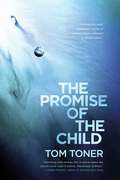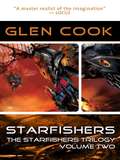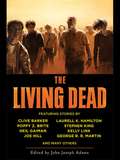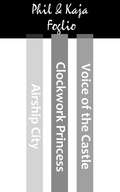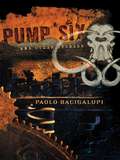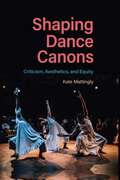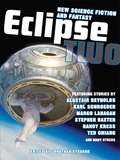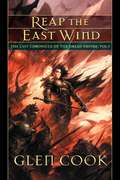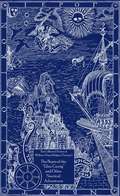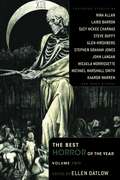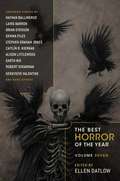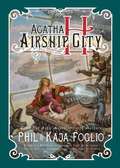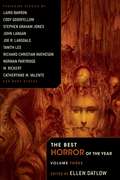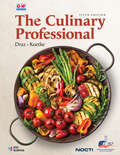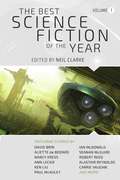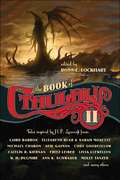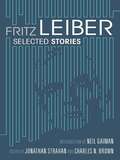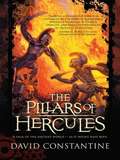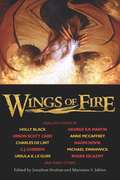- Table View
- List View
The Promise of the Child: of the Amaranthine Spectrum (The Promise of the Child)
by Tom TonerIt is the 147th century.In the radically advanced post-human worlds of the Amaranthine Firmament, there is a contender to the Immortal throne: Aaron the Long-Life, the Pretender, a man who is not quite a man.In the barbarous hominid kingdoms of the Prism Investiture, where life is short, cheap, and dangerous, an invention is born that will become the Firmament&’s most closely kept secret.Lycaste, a lovesick recluse outcast for an unspeakable crime, must journey through the Provinces, braving the grotesques of an ancient, decadent world to find his salvation.Sotiris, grieving the loss of his sister and awaiting the madness of old age, must relive his twelve thousand years of life to stop the man determined to become Emperor.Ghaldezuel, knight of the stars, must plunder the rarest treasure in the Firmament—the object the Pretender will stop at nothing to obtain.From medieval Prague to a lonely Mediterranean cove, and eventually far into the strange vastness of distant worlds, The Promise of the Child is a debut novel of gripping action and astounding ambition unfolding over hundreds of thousands of years, marking the arrival of a brilliant new talent in science fiction.
Starfishers
by Glen CookThe vendetta in space had started centuries before "Mouse" Storm was born with his grandfather's raid on the planet Prefactlas, the blood bath that freed the human slaves from their Sangaree masters. But one Sangaree survived—the young Norborn heir, the man who swore vengeance on the Storm family and their soldiers, in a carefully mapped plot that would take generations to fulfill. Now Mouse's father Gneaus must fight for an El Dorado of wealth on the burning half of the planet Blackworld. As the great private armies of all space clash on the narrow Shadowline that divides inferno from life-sheltering shade, Gneaus' half-brother Michael plays his traitorous games, and a man called Death pulls the deadly strings that threaten to entrap them all—as the Starfishers Trilogy begins.
The Living Dead
by John Joseph Adams"When there's no more room in hell, the dead will walk the earth!" From White Zombie to Dawn of the Dead, Resident Evil to World War Z, zombies have invaded popular culture, becoming the monsters that best express the fears and anxieties of the modern west. Gathering together the best zombie literature of the last three decades from many of today's most renowned authors of fantasy, speculative fiction, and horror, including Stephen King, Harlan Ellison, Robert Silverberg, George R. R. Martin, Clive Barker, Poppy Z. Brite, Neil Gaiman, Joe Hill, Laurell K. Hamilton, and Joe R. Lansdale, The Living Dead covers the broad spectrum of zombie fiction.
Girl Genius Trilogy (Girl Genius)
by Phil Foglio Kaja FoglioThe complete Girl Genius Trilogy, containing Agahtha H. and the Airship City, Agatha H. and the Clockwork Princess, & Agatha H. and the Voice of the Castle.
Pump Six and Other Stories
by Paolo BacigalupiPaolo Bacigalupi's debut collection demonstrates the power and reach of the science fiction short story. Social criticism, political parable, and environmental advocacy lie at the center of Paolo's work. Each of the stories herein is at once a warning, and a celebration of the tragic comedy of the human experience.The eleven stories in Pump Six represent the best Paolo's work, including the Hugo nominee "Yellow Card Man," the nebula and Hugo nominated story "The People of Sand and Slag," and the Sturgeon Award-winning story "The Calorie Man."
The Twilight of Lake Woebegotten
by Harrison GeillorA small town... a plucky heroine, a shiny vampire, and a hunky Native American rival with a secret. But all is not as it seems in Lake Woebegotten. Let Harrison Geillor reveal what lies beneath the seemingly placid surface. You'll Laugh. We promise.When Bonnie Grayduck relocates from sunny Santa Cruz California to the small town of Lake Woebegotten, Minnesota, to live with her estranged father, chief of the local two-man police department, she thinks she's leaving her troubles behind. But she soon becomes fascinated by another student — the brooding, beautiful Edwin Scullen, whose reclusive family hides a terrible secret. (Psst: they're actually vampires. But they're the kind who don't eat people, so it's okay.) Once Bonnie realizes what her new lover really is, she isn't afraid. Instead, she sees potential. Because while Bonnie seems to her friends and family to be an ordinary, slightly clumsy, easily-distracted girl, she's really manipulative, calculating, power hungry, and not above committing murder to get her way — or even just to amuse herself. This is a love story about monsters... but the vampire isn't the monster.
Shaping Dance Canons: Criticism, Aesthetics, and Equity
by Kate MattinglyAmerican Society for Aesthetics Selma Jeanne Cohen Prize in Dance AestheticsExamining a century of dance criticism in the United States and its influence on aesthetics and inclusionDance criticism has long been integral to dance as an art form, serving as documentation and validation of dance performances, yet few studies have taken a close look at the impact of key critics and approaches to criticism over time. The first book to examine dance criticism in the United States across 100 years, from the late 1920s to the early twenty-first century, Shaping Dance Canons argues that critics in the popular press have influenced how dance has been defined and valued, as well as which artists and dance forms have been taken most seriously.Kate Mattingly likens the effect of dance writing to that of a flashlight, illuminating certain aesthetics at the expense of others. Mattingly shows how criticism can preserve and reproduce criteria for what qualifies as high art through generations of writers and in dance history courses, textbooks, and curricular design. She examines the gatekeeping role of prominent critics such as John Martin and Yvonne Rainer while highlighting the often-overlooked perspectives of writers from minoritized backgrounds and dance traditions. The book also includes an analysis of digital platforms and current dance projects—On the Boards TV, thINKingDANCE, Black Dance Stories, and amara tabor-smith’s House/Full of BlackWomen—that challenge systemic exclusions. In doing so, the book calls for ongoing dialogue and action to make dance criticism more equitable and inclusive.
Eclipse 2
by Jonathan StrahanAn eclipse is a rare and unusual event, when the world is transformed and the sky becomes a dark eldritch thing. It's a time when anything could happen, when any kind of story just might be true. That sense of the strange and wonderful guides Eclipse: New Science Fiction and Fantasy, the second volume in an exciting new annual anthology series edited by acclaimed anthologist Jonathan Strahan.Set to become a major event on the science fiction and fantasy calendar, Eclipse: New Science Fiction and Fantasy gathers together new science fiction and fantasy stories by the best writers working today. You can see that in Eclipse Two, which features more extraordinary tales of the fantastic and astounding.
The Cloud Roads (The Books of the Raksura)
by Martha WellsMoon has spent his life hiding what he is — a shape-shifter able to transform himself into a winged creature of flight. An orphan with only vague memories of his own kind, Moon tries to fit in among the tribes of his river valley, with mixed success. Just as Moon is once again cast out by his adopted tribe, he discovers a shape-shifter like himself... someone who seems to know exactly what he is, who promises that Moon will be welcomed into his community. What this stranger doesn't tell Moon is that his presence will tip the balance of power... that his extraordinary lineage is crucial to the colony's survival... and that his people face extinction at the hands of the dreaded Fell! Now Moon must overcome a lifetime of conditioning in order to save and himself... and his newfound kin.
Reap the East Wind
by Glen CookIt has ended. It begins again. In Kavelin, Lady Nepanthe's new life with the wizard Varthlokkur is disturbed by visions of her lost son, while King Bragi Ragnarson and Michael Trebilcock scheme to help the exiled Princess Mist re-usurp her throne — under their thumb. In Shinsan, a pig-farmer's son takes command of Eastern Army, while Lord Kuo faces plots in his council and a suicide attack of two million Matayangans on his border. But in the desert beyond the Dread Empire, a young victim of the Great War becomes the Deliverer of an eons-forgotten god, chosen to lead the legions of the dead. And the power of his vengeance will make a world's schemes as petty as dust, blown wild in the horror that rides the east wind.This volume marks the beginning of the end. Reap the East Wind is the first step on the road to the long-delayed final chapter of Glen Cook's legendary Dread Empire series.
The Collected Fiction of William Hope Hodgson: Boats of Glen Carrig & Other Nautical Adventures
by William Hope HodgsonThe first of a five volume set collecting all of Hodgson's published fiction. Each volume contains one of Hodgson's novels, along with a selection of thematically-linked short fiction.
The Best Horror of the Year Volume 2 (Best Horror of the Year)
by edited by Ellen DatlowCelebrities take refuge in a white-walled mansion as plague and fever sweep into Cannes; a killer finds that the living dead have no appetite for him; a television presenter stumbles upon the chilling connection between a forgotten animal act and the Whitechapel Murders; a nude man unexpectedly appears in the backgrounds of film after film; mysterious lights menace the crew of a small plane; a little girl awakens to discover her nightlight--and more--missing; two sisters hunt vampire dogs in the wild hills of Fiji; lovers get more than they bargained for in a decadent discotheque; a college professor holds a classroom mesmerized as he vivisects Poe's "The Masque of the Red Death"...What frightens us, what unnerves us? What causes that delicious shiver of fear to travel the lengths of our spines? It seems the answer changes every year. Every year the bar is raised; the screw is tightened. Ellen Datlow knows what scares us; the seventeen stories included in this anthology were chosen from magazines, webzines, anthologies, literary journals, and single author collections to represent the best horror of the year.Legendary editor Ellen Datlow (Poe: New Tales Inspired by Edgar Allan Poe), winner of multiple Hugo, Bram Stoker, and World Fantasy awards, joins Night Shade Books in presenting The Best Horror of the Year, Volume Two.
Best Horror of the Year (Best Horror of the Year)
by Ellen DatlowFor over three decades, Ellen Datlow has been at the center of horror. Bringing you the most frightening and terrifying stories, Datlow always has her finger on the pulse of what horror readers crave. Now, with the seventh volume of this series, Datlow is back again to bring you the stories that will keep you up at night.Encompassed in the pages of The Best Horror of the Year have been such illustrious writers as:Neil GaimanKim RobinsonStephen KingLinda NagataLaird BarronMargo LanaganAnd many othersWith each passing year, science, technology, and the march of time shine light into the craggy corners of the universe, making the fears of an earlier generation seem quaint. But this &“light&” creates its own shadows. The Best Horror of the Year chronicles these shifting shadows. It is a catalog of terror, fear, and unpleasantness, as articulated by today&’s most challenging and exciting writers.
Infidel (Bel Dame Apocrypha)
by Kameron HurleyNyx is a bodyguard in Mustallah, the capital city of Nasheen. The centuries-long holy war between Nasheen and Chenja is taking its toll, with shortages and rationing causing the Queen to lose power and popularity. While protecting the daughter of a Ras Tiegan Diplomat, Nyx is attacked by a group of assassins. Nyx survives, but begins to suffer from a strange, debilitating condition that nobody can identify. Caught up in a whirl-wind of intrigue involving Bel Dam Assassins plotting against the Queen, Nyx must learn who the rouge Bel Dam is, and find a cure for her illness, while avoiding the wrath of the queen she is trying to protect. The danger that swirls around her may have finally become to much, and Nyx's colleagues and friends began to die. Will Nyx be next?
Agatha H. and the Airship City (Girl Genius)
by Phil Foglio Kaja FoglioThe Industrial Revolution has escalated into all-out warfare. It has been eighteen years since the Heterodyne Boys, benevolent adventurers and inventors, disappeared under mysterious circumstances. Today, Europe is ruled by the Sparks, dynasties of mad scientists ruling over — and terrorizing — the hapless population with their bizarre inventions and unchecked power, while the downtrodden dream of the Hetrodynes' return.At Transylvania Polygnostic University, a pretty, young student named Agatha Clay seems to have nothing but bad luck. Incapable of building anything that actually works, but dedicated to her studies, Agatha seems destined for a lackluster career as a minor lab assistant. But when the University is overthrown by the ruthless tyrant Baron Klaus Wulfenbach, Agatha finds herself a prisoner aboard his massive airship Castle Wulfenbach — and it begins to look like she might carry a spark of Mad Science after all.
Black Butterflies
by John ShirleyThis collection of gritty and intense short stories compares the horrors of the real world to those of the supernatural. Winner of the Bram Stoker Award, the International Horror Guild Award, and a Publishers Weekly Best Book of the Year.
The Best Horror of the Year (Best Horror of the Year)
by Ellen DatlowA doctor makes a late-night emergency call to an exclusive California riding school; a professor inherits a mysterious vase... and a strange little man; a struggling youth discovers canine horrors lurking beneath the streets of Albany; a sheriff ruthlessly deals with monstrosities plaguing his rural town; a pair of animal researchers makes a frightening discovery at a remote site; a sweet little girl entertains herself... by torturing faeries; a group of horror aficionados attempts to track down an unfinished film by a reclusive cult director; a man spends a chill night standing watch over his uncle's body; a girl looks to understand her place in a world in which zombies have overrun the earth; a murderous pack of nuns stalks a pair of Halloween revelers...What frightens us, what unnerves us? What causes that delicious shiver of fear to travel the lengths of our spines? It seems the answer changes every year. Every year the bar is raised; the screw is tightened. Ellen Datlow knows what scares us; the seventeen stories included in this anthology were chosen from magazines, webzines, anthologies, literary journals, and single author collections to represent the best horror of the year.Legendary editor Ellen Datlow (Lovecraft Unbound, Tails of Wonder and Imagination), winner of multiple Hugo, Bram Stoker, and World Fantasy awards, joins Night Shade Books in presenting The Best Horror of the Year, Volume Three.
The Culinary Professional
by Christopher Koetke John DrazThe Culinary Professional is a richly illustrated, comprehensive, culinary arts program written with an approachable writing style and design. Hundreds of photos of professional tools and ingredients plus step-by-step directions for basic culinary skills and cooking methods make this textbook a must-have for learning how to safely prepare delicious dishes. This title also includes cross-curricular activities in reading, writing, science, technology, math, nutrition, and sustainability, along with guidance for students on building a professional e-portfolio to help launch a successful career. When paired with the student workbook and hands-on activities in the student lab manual, important learning outcomes focused on critical thinking, culinary skills, problem solving, collaboration, and communication can be practiced and successfully mastered. Experienced authors, educators, and chefs John Draz and Christopher Koetke focus on what to expect when entering the culinary arts industry, from workplace ethics to working in teams to developing tasting skills for quality control. The fifth edition is structured into sections of text followed by review questions within targeted lessons to reinforce student mastery of new skills and knowledge.
The Best Science Fiction of the Year (Best Science Fiction of the Year)
by Neil ClarkeTo keep up-to-date with the most buzzworthy and cutting-edge science fiction requires sifting through countless magazines, e-zines, websites, blogs, original anthologies, single-author collections, and more—a task accomplishable by only the most determined and voracious readers. For everyone else, Night Shade Books is proud to introduce the inaugural volume of The Best Science Fiction of the Year, a new yearly anthology compiled by Hugo and World Fantasy award–winning editor Neil Clarke, collecting the finest that the genre has to offer, from the biggest names in the field to the most exciting new writers.The best science fiction scrutinizes our culture and politics, examines the limits of the human condition, and zooms across galaxies at faster-than-light speeds, moving from the very near future to the far-flung worlds of tomorrow in the space of a single sentence. Clarke, publisher and editor in chief of the acclaimed and award-winning magazine Clarkesworld, has selected the short science fiction (and only science fiction) best representing the previous year&’s writing, showcasing the talent, variety, and awesome &“sensawunda&” that the genre has to offer.Neil Clarke is the award-winning publisher and editor in chief of Clarkesworld magazine, winner of three Hugo Awards for Best Semiprozine, and the editor of the 2014 cyborg-themed original anthology Upgraded. Clarke lives in Stirling, New Jersey.
The Book of Cthulhu 2
by Ross LockhartLast year, Night Shade Books unleashed The Book of Cthulhu onto an unsuspecting world. Critically acclaimed as &“the ultimate Cthulhu anthology&” and &“a &‘must read&’ for fans of Lovecraft&’s Cthulhu mythos,&” The Book of Cthulhu went where no collection of mythos tales had gone before: to the very edge of madness… and beyond.For nearly a century, H. P. Lovecraft&’s tales of malevolent Great Old Ones existing beyond the dimensions of this world, beyond the borders of sanity, have captured and held the imaginations of writers and aficionados of the dark, the macabre, the fantastic, and the horrible. Now, because you demanded more, anthologist Ross E. Lockhart has risked all to dive back into the Cthulhu canon, combing through mind-shattering manuscripts and moldering tomes to bring you The Book of Cthulhu 2, with even more tales of tentacles, terror, and madness.Featuring monstrous stories by many of weird fiction&’s brightest lights, The Book of Cthulhu 2 brings you even more tales inspired by H. P. Lovecraft&’s greatest creation: The Cthulhu mythos.This year, the stars are right…Iä! Iä! Cthulhu Fhtagn!
Stories of the Raksura: The Tale of Indigo and Cloud
by Martha Wells&“The Tale of Indigo and Cloud&” explores the history of the Indigo Cloud Court, long before Moon was born. In the distant past, Indigo stole Cloud from Emerald Twilight. But in doing so, the reigning Queen Cerise and Indigo are now poised for a conflict that could spark war throughout all the courts of the Reaches.
The King's Daughters
by Nathalie MalletFar to the north of the hot desert land of Telfar lies the frozen kingdom of Sorvinka. Prince Amir has traveled there, leaving his sultanate in the hands of his half-brother Erik as he seeks to ask the king, the father of the beautiful Princess Eva, for her hand in marriage. But Sorvinka has grown dangerous during Princess Eva's absence, as she and Amir discover to their terror, when their force of guards and eunuchs is cut down by ruthless brigands. And upon their arrival, their welcome to Eva's family stronghold is as bitterly cold as the land itself. Accustomed to the golden cage of his upbringing, Prince Amir must navigate his way through the strange and cold-blooded customs of the Sorvinkans, and somehow find the truth behind the kidnapping of the king&’s youngest daughter, the Princess Aurora, by the Sorvinkan&’s traditional enemies, the neighboring Farrellians. But what can a stranger in a foreign land do?
Fritz Leiber: Selected Stories
by Fritz LeiberFritz Leiber's work bridges the gap between the pulp era of H. P. Lovecraft and the paperback era of P. K. Dick, and arguably is as influential as both these authors. From a historical context, Leiber, in fact, knew both of the authors, and his work can be seen as a bridge connecting the many different flavors of genres of science fiction, fantasy, and horror. Edited by award-winning editors Jonathan Strahan and Charles Brown, this new collection of the grand master's fiction covers all facets of his work, and features an Introduction by Neil Gaiman and an Afterword by Michael Chabon.
The Pillars of Hercules
by David ConstantineAlexander, Prince of Macedon, is the terror of the world. Persia, Egypt, Athens… one after another, mighty nations are falling before the fearsome conqueror. Some say Alexander is actually the son of Zeus, king of the gods, and the living incarnation of Hercules himself. Worse yet, some say Alexander believes this…The ambitious prince is aided in his conquest by unstoppable war-machines based on the forbidden knowledge of his former tutor, the legendary scientist-mage known as Aristotle. Greek fire, mechanical golems, and gigantic siege-engines lay waste to Alexander's enemies as his armies march relentlessly west—toward the very edge of the world.Beyond the Pillars of Hercules, past the gateway to the outer ocean, lies the rumored remnants of Atlantis: ancient artifacts of such tremendous power that they may be all that stands between Alexander and conquest of the entire world. Alexander desires that power for himself, but an unlikely band of fugitives—including a Gaulish barbarian, a cynical Greek archer, a cunning Persian princess, and a sorcerer's daughter—must find it first… before Alexander unleashes godlike forces that will shatter civilization.The Pillars of Hercules is an epic adventure that captures the grandeur and mystery of the ancient world as it might have been, where science and magic are one and the same.
Wings of Fire
by Jonathan Strahan Marianne S. JablonDragons: Fearsome fire-breathing foes, scaled adversaries, legendary lizards, ancient hoarders of priceless treasures, serpentine sages with the ages' wisdom, and winged weapons of war... Wings of Fire brings you all these dragons, and more, seen clearly through the eyes of many of today's most popular authors, including Peter Beagle, Holly Black, Orson Scott Card, Charles De Lint, Diana Wynne Jones, Mercedes Lackey, Ursula K Le Guin, Dean R Koontz, George R. R. Martin, Anne McCaffrey, Elizabeth Moon, Garth Nix, and many others.
